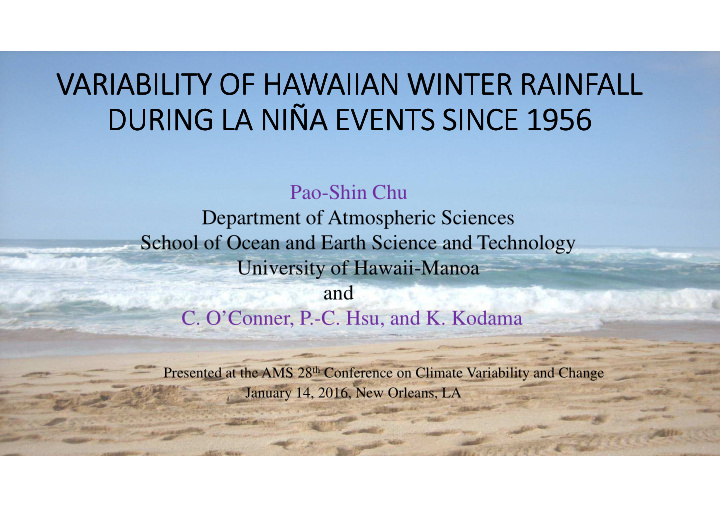



VARIABILITY OF HAWAIIAN WINTER RAINFALL VARIABILITY OF HAWAIIAN WINTER RAINFALL VARIABILITY OF HAWAIIAN WINTER RAINFALL VARIABILITY OF HAWAIIAN WINTER RAINFALL DURING LA NIÑA EVENTS DURING LA NIÑA EVENTS SINCE 1956 SINCE 1956 DURING LA NIÑA EVENTS DURING LA NIÑA EVENTS SINCE 1956 SINCE 1956 Pao-Shin Chu Department of Atmospheric Sciences School of Ocean and Earth Science and Technology University of Hawaii-Manoa and C. O’Conner, P.-C. Hsu, and K. Kodama Presented at the AMS 28 th Conference on Climate Variability and Change January 14, 2016, New Orleans, LA
HRI (Hawaii Rainfall Index) Standardized anomalies
HRI El Niño (La Niña) occurs if 5-mo running mean of SST anomalies in Nino 3.4 region exceeds 0.4°C (-0.4°C) for at least 6 consecutive months Chu, 1995, J. Climate; Chu and Chen, 2005, J. Climate
Why rainfall in Hawaii has decreased since the early 1980s? • 50 stations with complete rainfall records for 1956- 2010 • NWS-Honolulu Office • Oceanic Nino Index (ONI) – NOAA/Climate Prediction Center • El Nino (La Nina) event: 3-mo running mean of SSTs in the Nino3.4 region greater (less) than 0.5C (-0.5C) for five consecutive, overlapping seasons (e.g., JFM, FMA,…) • NCEP/NCAR reanalysis 1 for circulation study
Standardized rainfall anomalies during wet season (NDJFMA). La Niña events during epoch 1 (1956-1982) and epoch 2 (1983-2010) are marked by black diamonds and white squares, respectively. Note the drying trend indicated by the straight line. 2 1.5 1 Standardized Anomalies 1956-1982 0.5 1983-2010 0 1950 1960 1970 1980 1990 2000 2010 -0.5 -1 Based on Pettitt-Mann-Whitney change-point test, the most likely shift occurs in 1983 (p-value = 0.06)
• The data series is then partitioned into 2 epochs: 1956-1982 as the first epoch (E1) and 1983-2010 as the second epoch (E2). • The Wilcoxon-Mann-Whitney rank sum test indicates that the average rainfall anomalies during E1 are significantly different from that during E2 with a p- value of 0.01 (very significant!)
• Rainfall trend for El Niño years is downward and trend for Neutral years (not fallen into El Niño and La Niña groups) is upward, but none of them are statistically significant • Downward trend in HRI since the early 1980s appears to be caused mainly by decreasing rainfall during La Nina events
• Rainfall anomalies in La Nina years are categorized as either drier than normal (Z<-0.43), wetter than normal (Z>0.43), or near normal (between -0.43 and +0.43), where Z is the standardized rainfall anomalies. • This tercile categorization (i.e., top, middle, bottom) has been commonly used in operational centers.
Time series of standardized rainfall anomalies. La Niña events during epoch 1 (1956-1982) and epoch 2 (1983-2010) are marked by black diamonds and white squares, respectively. 2 1.5 1 Standardized Anomalies 1956-1982 0.5 1983-2010 0 1950 1960 1970 1980 1990 2000 2010 -0.5 E1: All Z are positive and 3/7 are in the top tercile -1 (wetter than normal) E2: only 2/11 are in the top tercile; 5 are negative
Seasonal mean geopotential height (m) in lower troposphere (850 hPa) during La Niña wet seasons. In (c), the grey shaded area is where the null hypothesis was rejected at the 5% level. Solid (dashed) contours denote positive (negative) value. E1 1540 150 ° W E2 165 ° W 1540 E2-E1 +
Seasonal mean wind ( �� �� ) at 925 hPa during La Niña wet seasons. (a) Epoch 1 (1956-1982). (b) Epoch 2 (1983-2010). Lower troposphere E1 E2
Seasonal mean zonal wind ( �� �� ) at 200 hPa during the La Niña wet seasons. The grey shaded area is where the null hypothesis of the rank sum test was rejected at the 5% level. Solid (dashed) contours in (c) denote westerly (easterly) direction. Upper 60 E1 40 troposphere 178W 60 E2 40 170W + E2-E1
La Niña Midlatitude Fronts Kona Lows Upper-level Lows Rainfall Anomaly Wet Seasons 1956 15 3 2 0.16 1964 18 5 2 0.50 1970 11 6 8 1.26 1971 9 10 3 0.21 18.5°-22.5°N 1973 17 5 7 0.90 1974 9 4 6 0.23 159.5°-154.5°W 1975 14 5 6 0.27 1983 11 2 1 -0.93 1984 13 5 4 0.06 1988 14 3 2 1.70 1995 12 4 3 -0.02 1998 8 1 4 -0.39 1999 6 1 4 -0.81 2000 10 1 2 -0.83 2005 8 4 6 0.53 Chu, Nash, and Porter, 2007 12 3 6 0.06 1993, J. Climate 2008 8 5 5 -0.11 2010 10 4 7 0.14 E1 AVG 13.3 5.4 4.9 0.50 E2 AVG 10.2 3.0 4.0 -0.05 (E2 – E1) -3.1 -2.4 -0.9 -0.55 E2/E1 - 0.77 (23%↓) 0.56 0.82 (44%↓) (18%↓)
Summary • Historically, Hawaii experienced low rainfall during El Nino events and abundant rainfall during La Nina events. • A drying trend in Hawaii rainfall during La Nina years is evident. A change-point analysis determined that the shift occurs in 1983, forming 2 epochs (1956-1982 and 1983-2010). • Tropical SSTs and circulation features in the North Pacific (e.g., Trenberth and Hurrell, 1994) have concurrently changed, thus possibly causing changes in La Nina year rainfall. • The strengthening, and westward shifting of the eastern North Pacific subtropical high, coupled with the eastward elongation of the subtropical jet stream, are two main influences.
• Moisture transport analysis shows a reduction of moisture flux convergence in the Hawaii region during the second epoch. Changes in the circulation terms (i.e., dynamic effect) are found to be the primary driving force for the difference in moisture convergence surrounding Hawaii from E1 to E2. • Additionally, a storm track analysis found fewer Kona lows and midlatitude fronts in the vicinity of Hawaii over the last 60 years. Decrease in these kinds of rain- bearing systems contributes mainly to a decline in La Nina rainfall since 1983. O’Conner, Chu, Hsu, and Kodama, 2015, J. Climate
Recommend
More recommend